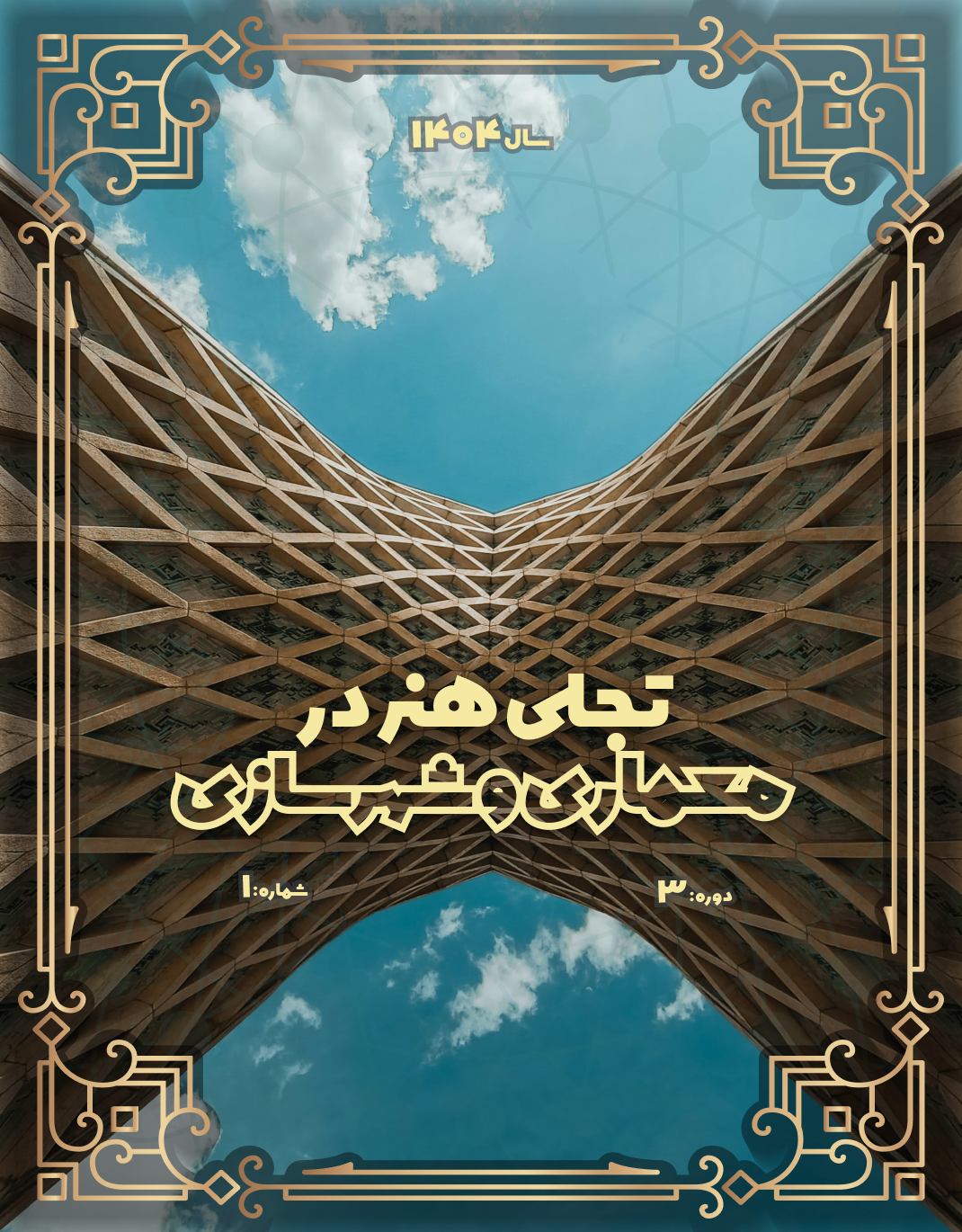Examining the Impact of Building Façade Material Reflection on the Increase of Ambient Temperature in Urban Heat Island (UHI) Phenomenon (Case Study: Tehran)
Keywords:
Reflection, building facade materials, mbient temperature, urban heat islandAbstract
With the rise of urbanization and construction density in metropolitan areas, the phenomenon of Urban Heat Island (UHI) has become one of the major challenges in the field of urban climatology. Among the contributing factors, building materials, and particularly urban façades as vertical surfaces exposed to solar radiation, play a significant role in either intensifying or mitigating ambient temperature levels. The objective of this study is to evaluate the effect of different façade materials on ambient dry temperature in an urban case study. For this purpose, the southern section of Phase 1 of Ekbatan Town in Tehran was selected as the study area. Using Grasshopper software along with the Ladybug and Dragonfly plugins, three different scenarios were modeled and simulated: the current condition (concrete and stone façades), fully glazed façades, and a condition without anthropogenic elements (traffic, population, green spaces). The output data were analyzed through the UWG engine and compared with reference climatic data. The results indicated that highly reflective materials, particularly glass, cause a significant increase in ambient temperature during peak solar radiation hours (09:00–15:00). In the glazed façade scenario, the maximum temperature difference compared to the reference condition exceeded 5.5°C. These findings highlight the importance of considering appropriate material selection in urban façade design in order to reduce the negative impacts of UHI and to enhance outdoor thermal comfort.
Downloads
References
1. Hajian Zeidy M, Ghadarjani R, Zaheri M. Sustainable Urban Reconstruction in Historical Texture: Academic Center for Education, Culture and Research (Jahade Daneshgahi); 2021.
2. Gholami H, Kamelnia H, Mahdavinejad MJ, Sangin H. Optimizing Building Configuration and Orientation for Social Housing Projects in Iran. Iranica Journal of Energy & Environment. 2025;16(2):289-308.
3. Jafri A, Villenuve E, Agelin-Chaab M, Hangan H. Experimental investigation of building mock-ups and air source heat pumps in cold climates. Energy and Built Environment. 2025.
4. Jahanbakhsh H, Daneshjoo F, Sheibani N, Sheibani H. Analyzing the Characteristics of Architecture and the Structure of 'Urban'Design in 'Arsen-e Zandieh', Shiraz. Iranian Urban Design Studies. 2025;1(2):321-44.
5. Zaina SM, Fadli F, Hosseini SM. Evaluation of smart irrigation systems in hot-arid climates for green roofs and walls: case of Doha, Qatar. Smart and Sustainable Built Environment. 2022;11(2):346-67.
6. Sterkel M, Kider Jr JT. A comparative study of infrared thermography for improving defect detection for Radio Frequency equipment on communication towers. Measurement. 2025;253:117254.
7. Sharmin T, Chappell A. Detecting the changing impact of urbanisation on urban heat islands in a tropical megacity using local climate zones. Energy and Built Environment. 2025.
8. Sadeghe Sabery MJ, Zahedi Yegane A, Hajian Zeidy M, Ghadarjani R. Evaluation of quality of life in the Paradise neighborhood Mehr Housing Case with emphasis on sustainable development in Hamedan. Journal of Geography and Environmental Studies. 2018;7(27):1-24.
9. Zaheri M, Saremi HR, Hajian Zeidy M. Measuring the Impact of Technology Components on Islamic-Iranian Culture to Build New Sustainable Urban Settlements in Dorud. Geography (Regional Planning). 2022;13(1):359-73.
10. Talaei M, Sangin H. Thermal comfort, daylight, and energy performance of envelope-integrated algae-based bioshading and static shading systems through multi-objective optimization. Journal of Building Engineering. 2024;90:109435.
11. Hajian Zeidy M, Sufinejad A. Sustainable Architecture Indicators in Iranian Buildings: Academic Center for Education, Culture and Research (Jahade Daneshgahi); 2023.
12. Voogt JA, Oke TR. Thermal remote sensing of urban climates. Remote sensing of environment. 2003;86(3):370-84.
13. Tabatabaei SS, Fayaz R. The effect of facade materials and coatings on urban heat island mitigation and outdoor thermal comfort in hot semi-arid climate. Building and Environment. 2023;243:110701.
14. Jahanbakhsh H. Study about realizability situation and utilization contexts of water sensitive urban design. International Journal of Architecture and Urban Development. 2017;7(4):41-8.
15. Hajian Zeidy M, Rouhi M, Razavi Amrei SG. Effect of Passive Solar Cooling Systems Performance on Indoor Air Quality in Buildings. Development Engineering Conferences Center Articles Database. 2024;1(1).
16. Tabassum A, Park K, Hong SH, Baik JJ, Han BS. Impacts of cool roofs on urban heat island and air quality in Dhaka, Bangladesh: A case modeling study during a heat wave. Atmospheric Pollution Research. 2025:102549.
17. Hosseini SM, Heidari S. General morphological analysis of Orosi windows and morpho butterfly wing's principles for improving occupant's daylight performance through interactive kinetic façade. Journal of Building Engineering. 2022;59:105027.
18. Siddiqui A, Maske AB, Khan A, Kar A, Bhatt M, Bharadwaj V, et al. An Urban Climate Paradox of Anthropogenic Heat Flux and Urban Cool Island in a Semi-Arid Urban Environment. Atmosphere. 2025;16(2).
19. El Kenawy AM, Abdelaal MM, Aboelkhair H, Mohamed EK. Urban comfort dynamics in major megacities in the middle East: A Spatiotemporal assessment and linkage to weather types. Urban Climate. 2025;59:102309.
20. Heidari S. Thermal comfort in Iranian courtyard housing: University of Sheffield; 2000.
21. Amani MJ, Tanzadeh R, Moghadas Nejad F, Kabiri Nasrabad MM, Chalabii J, Movahedi Rad M. Urban Sustainability Through Pavement Technologies: Reducing Urban Heat Islands with Cool Pavements. Buildings. 2025;15(3):504.
22. Sharston R, Singh M. Urban morphology, urban heat island (UHI) and building energy consumption: A critical review of methods and relationships among influential parameters. Building Services Engineering Research & Technology. 2025:01436244251339727.
23. Jahanbakhsh H, Koumleh MH, Alambaz FS. Methods and techniques in using collective memory in urban design: achieving social sustainability in urban environments. Cumhur Univ Fac Sci J(CSJ). 2015;36:13.
24. Li H, Cai Y, Yang Y, Cai X. Assessing the influence of urban scene characteristics on urban heat island: An interpretable machine learning approach in New York City. Urban Climate. 2025;62:102542.
25. Zamani Z, Heidari S, Hanachi P. Reviewing the thermal and microclimatic function of courtyards. Renewable and Sustainable Energy Reviews. 2018;93:580-95.
26. Chen Y, Ma W, Shao Y, Wang N, Yu Z, Li H, et al. The impacts and thresholds detection of 2D/3D urban morphology on the heat island effects at the functional zone in megacity during heatwave event. Sustainable Cities and Society. 2025;118:106002.
27. Heidari S, Sharples S. A comparative analysis of short-term and long-term thermal comfort surveys in Iran. Energy and Buildings. 2002;34(6):607-14.
28. Wang M, Wang X, Luan Q, Xu X. A new perspective to assess urban heat islands by incorporating both canopy and boundary layer air temperature from the view of satellite remote sensing. Sustainable Cities and Society. 2025;125:106315.
29. Wang X, Li H, Sodoudi S. The effectiveness of cool and green roofs in mitigating urban heat island and improving human thermal comfort. Building and Environment. 2022;217:109082.
30. Xiao XD, Dong L, Yan H, Yang N, Xiong Y. The influence of the spatial characteristics of urban green space on the urban heat island effect in Suzhou Industrial Park. Sustainable Cities and Society. 2018;40:428-39.
31. Shafiee E, Faizi M, Yazdanfar SA, Khanmohammadi MA. Assessment of the effect of living wall systems on the improvement of the urban heat island phenomenon. Building and environment. 2020;181:106923.
32. Chen J, Jin S, Du P. Roles of horizontal and vertical tree canopy structure in mitigating daytime and nighttime urban heat island effects. International Journal of Applied Earth Observation and Geoinformation. 2020;89:102060.
33. Zhao TF, Fong KF. Characterization of different heat mitigation strategies in landscape to fight against heat island and improve thermal comfort in hot-humid climate (Part I): Measurement and modelling. Sustainable cities and society. 2017;32:523-31.
34. Schibuola L, Tambani C. Performance assessment of seawater cooled chillers to mitigate urban heat island. Applied Thermal Engineering. 2020;175:115390.
35. Xie N, Li H, Abdelhady A, Harvey J. Laboratorial investigation on optical and thermal properties of cool pavement nano-coatings for urban heat island mitigation. Building and Environment. 2019;147:231-40.
36. Fabiani C, Pisello AL, Bou-Zeid E, Yang J, Cotana F. Adaptive measures for mitigating urban heat islands: The potential of thermochromic materials to control roofing energy balance. Applied Energy. 2019;247:155-70.
37. Yang YK, Kim MY, Chung MH, Park JC. PCM cool roof systems for mitigating urban heat island-an experimental and numerical analysis. Energy and Buildings. 2019;205:109537.
38. Akbari H, Kolokotsa D. Three decades of urban heat islands and mitigation technologies research. Energy and buildings. 2016;133:834-42.
39. Santamouris M. Cooling the cities-a review of reflective and green roof mitigation technologies to fight heat island and improve comfort in urban environments. Solar energy. 2014;103:682-703.
40. Yuan J, Masuko S, Shimazaki Y, Chai J. Researching the design of a glass-bead retro-reflective material to reduce downward reflection for urban heat island mitigation. Materials Today Sustainability. 2022;18:100147.
41. Rossi F, Pisello AL, Nicolini A, Filipponi M, Palombo M. Analysis of retro-reflective surfaces for urban heat island mitigation: A new analytical model. Applied energy. 2014;114:621-31.
42. Susca T, Zanghirella F, Colasuonno L, Del Fatto V. Effect of green wall installation on urban heat island and building energy use: A climate-informed systematic literature review. Renewable and Sustainable Energy Reviews. 2022;159:112100.
43. Asadi A, Arefi H, Fathipoor H. Simulation of green roofs and their potential mitigating effects on the urban heat island using an artificial neural network: A case study in Austin, Texas. Advances in Space Research. 2020;66(8):1846-62.
44. Han T, Du C, Xie Y, Xian X, Zhang X, Yang B, et al. A 3D perspective for understanding the mechanisms of urban heat island and urban morphology using multi-modal geospatial data and interpretable machine learning. Building and Environment. 2025:113184.
45. Wang W, Yao X, Shu J. Monitoring Diurnal Variations and Displacement of Surface Urban Heat Islands Using 10-minute Himawari-8 Data for Urban Climate Adaptation. Sustainable Cities and Society. 2025:106586.
46. Tabassum A, Hong SH, Park K, Baik JJ. Simulating urban heat islands and local winds in the Dhaka metropolitan area, Bangladesh. Urban Climate. 2025;59:102284.
47. Jato-Espino D, Lierow S, Rodríguez-Sánchez MÁ. Using classification algorithms to model nighttime Surface Urban Heat Island (SUHI), with an emphasis on the role of urban trees. Building and Environment. 2025;270:112572.
48. Wu T, Chen Z, Zhou S, Huang R, Xing P, Li S, et al. Joint evaluation of urban built environment's driving patterns on urban heat island (UHI) and urban moisture island (UMI). Sustainable Cities and Society. 2025:106450.
49. An Z, Ming Y, Liu Y, Zhang G. Investigating 2D/3D factors influencing surface urban heat islands in mountainous cities using explainable machine learning. Urban Climate. 2025;59:102325.
50. Najjar M, Indraganti M, Furlan R. The Role of Building Geometry in Urban Heat Islands: Case of Doha, Qatar. Designs. 2025;9(3):77.
51. Martinelli A, Carlucci F, Fiorito F. On the role of the building envelope on the urban heat island mitigation and building energy performance in Mediterranean cities: A case study in southern Italy. Climate. 2024;12(8):113.
52. De Masi RF, Festa V, Gigante A, Ruggiero S, Vanoli GP. Comprehensive analysis of the incidence of glazed components and PV system degradation on the achievement of nearly zero energy balance under extreme events and climate changes. Energy Reports. 2024;11:4397-411.
Downloads
Published
Submitted
Revised
Accepted
Issue
Section
License
Copyright (c) 2025 Seyed Gholamreza Razavi Amrei (Author); Heydar Jahanbakhsh; Abdollah Ebrahimi (Author)

This work is licensed under a Creative Commons Attribution-NonCommercial 4.0 International License.










